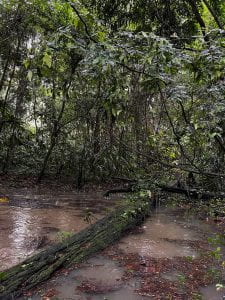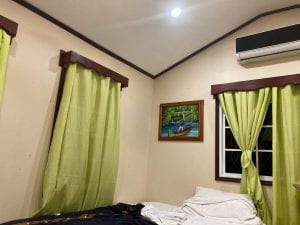Category Archives: 2022
Day 12: Speedy TFBs
Today we started off our last day in Las Cuevas by collecting our arthropod pitfall traps and sorting through the data in the morning. We found that there were more insects on the forest floor than in the canopy but the we were wrong about the canopy arthropods would be more attracted to the nitrogen rich trap. Afterwards, some people started our poster while me, Dr. Correa, and a few others sped hiked through the motion camera trap trails to collect them and get the data. It was super fun to speed hike through and see the same plants and areas of trail in a completely different way. Now that we didn’t have to worry about biasing data placement, etc., I was able to hike and just enjoy it as a hike itself. What’s even better is that it started to rain pretty hard once we finished the steep uphill of Bird Tower Trail so we were nice and refreshed by the time we returned to the station. The rain was also beautiful to watch and listen to, the ponds slowly filling up and preparing themselves for the many frogs that will soon inhibit them.
After we finished up packing and were waiting for the vans, one of the station managers Darrio pointed out that you could hear what sounded like hundreds of Mexican Burrowing Toads croaking from the wallows/frog pond area. A few of us decided to check it out and it was so cool. Once you step into the pond area, it was a 360º surrounding of the frogs croaking. Sadly we didn’t see any as they are burrowed in the ground but it was still really cool to hear them as the wet season kicks in.
Once we left Las Cuevas and made our way to the hotel, I was able to still spot lots of epiphytes. Since settling in our new rooms, I have identified lots of Tillandsia spp. and Philodendron hederaceum. It’s pretty cool to see that they still thrive outside of the forest – and who knows, maybe I’ll be able to spot some back in Houston (in the wild or as house plants) 😉
– Sophia
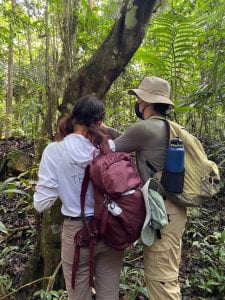
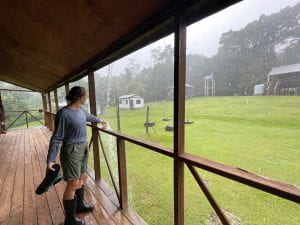

Day 11: Lucky Charm TFBs (Sorry for Jinxing It)
Two true TFB experiences today: I woke up at 5am to join some of the group for some bird watching and peed in a test tube. Waking up was a little rough at first but it was worth it. It was super cool to see the morning mist around the fog and drink coffee while watching the Black Vultures hang out on their canopy spot. The dawn chorus was also super pretty (where all of the birds sing in the morning) and looking out into the trees while waking up was pretty peaceful. I also got some people to start throwing around a frisbee !! But I promise ultimate ishn’t my main personality trait… After breakfast, we started our next experiment – seeing the differences of arthropod abundance in the canopy versus the forest floor. One way to test this is by placing a pitfall trap with nitrogen in it and a water in the other one. How do you get the nitrogen source into the pitfall? Our pee.
For the rest of the morning before lunch we set up our 64 pitfall traps on the tree and in the forest floor. I spotted some Mistletoe Cactus (an epiphyte) too! And of course lots of Tillandsia spp., Monstera spp., and Philodendron radiatum and hederacum. As soon as we got on the trail to set up, we came across a Jumping Pit Viper and an Eyelash Viper. Apparently the manager of the station hasn’t seen on in the wild in the past 12 years and it’s insane that we were able to find one. Then after lunch, we got to excavate some Leaf Cutter Ant nests to try to find their fungal garden looking at young ones first and then old ones. While searching for the nests and prepping for the excavation we saw a Tarantula Hawk, scorpions, a Orb-Weaver Spider, and Ant Lion holes. When we looked through the young one, we were able to find the queen which was absolutely giant – she can live up to 25 years and has a bunch of eggs that she lays over time after only mating once. Two kinds of worker ants that work as a defense layer are called Majors and Soldiers. These have huge heads that have really sharp mandibles and do not hesitate to bite you and draw blood. While looking at the first of the two bigger nests, we found a rare (to find) Mexican Burrowing Toad which was SO cute and funny looking. A big highlight of the day was seeing a super happy and excited Rusty. Looking at the second of the larger nests, there was many more major and soldier ants, and a much larger fungal garden and we got to see the architecture of the nest more.
After dinner, as we got to go on an optional night hike which was definitely 100% 12/10 worth doing, I almost stopped on a Red-Rump Tarantula. I really think my clumsiness has amplified 10 fold over the past week and a half. As we walked through the trail, it really felt like we were on the set of a movie with the way our headlamp moved across the towering palms. We encountered two (!!) Morelet’s Tree Frogs which is a critically endangered species which is tragic as these guys are super cute. They even jumped on some people and we had a fun tree frog photoshoot. As we made it to the same wallow as yesterday, we saw that the same Red-Eyed Tree Frog (possibly Morelet’s as well) eggs where being preyed upon by a Northern Cat Eye snake. We actually got to watch the snake’s process of stalking the eggs slowly and taking multiple trips to get as many eggs as possible. It was super cool to be able to observe behaviors of the more nocturnal organisms and basically unlock another world.
-Sophia
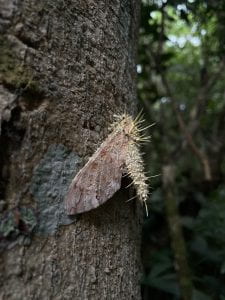
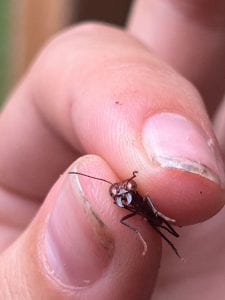

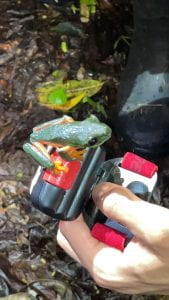
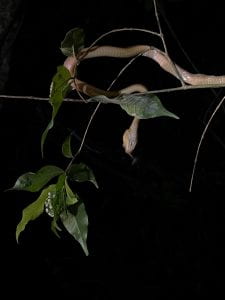
Day 10: New Heights
This morning after breakfast, we created our camera trap experiment in which we are going to use fifteen motion cameras that will take photos over the next few days. We are going to try to identify the different predators and prey and see where they might be most abundant in the different areas of the foot trails, untouched forest, and the “paved” roads. We set out for a couple of hours before lunch to begin our camera set up, mainly putting up our five cameras for the road areas. After lunch, we then set out for the true hiking experience to put up the other 10 or so cameras. I was impressed with the amount of elevation that we gained throughout the hike, rubber boots adding to some of the difficulty when we had to go down hill (they are super important for protection against snakes and also great for the rain and puddles) but I think this is because mine could do with some extra traction but I still very much enjoyed the hike. The vegetation within the forest was unbelievable. I just feel like everything is magnified by 10x, it’s gorgeous. I saw huge Give and Take Palms, plenty of fish tail palms, huge Tillandsia utriculata (the same genus as the small airplants but this one can grow up to 60cm) in many of the tree canopies, and a lot of house plants that were obviously thriving more out here in the jungle than someone’s plant room: Philodendron radiatum, Philodendron hederaceum and a lot of Monstera spp. I also saw a lot of air-plants that were both on the tree at around eye level but also a few that had fallen to the ground because the branch that they were connected to had broken off. These were Tillandsia spp. but they all are so similar that I’m learning that deciphering the exact species is going to be more difficult than I expected. Along the way, we saw so many different butterflies, a huge cockroach, lots of cicada shells, leaf cutter ants, and even got to eat some termites. Since they were so small, it wasn’t scary to eat them – they mostly had a woody aftertaste to them but I don’t know if I’d go out of my way to find and eat them.

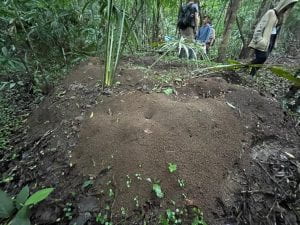
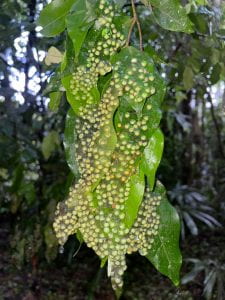
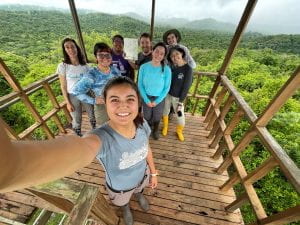

After we finished the elevation climb, we made it to the Bird Tower where we went up this questionably stable structure that had the most amazing outlook I have ever seen. You could see so much of the forest yet only understand that it is only a part of the whole thing, it was gorgeous. On the hike down from the top, we stopped at the smaller Mayan cave were we found some Mayan clay pottery shards and got to explore the room that had been built by building a wall into the natural constrictions of the cave. The stalactites were so impressive and I could have stared at them all day, but I’m excited for the cave we get to explore in a few days. As we were trying to pass the time, I have also learned so many riddles and I can’t wait to stump everyone one at home. On the way back down Dr. Solomon also pointed out some orchids but I couldn’t identify them because there were no flowers. However, pseudobulbs led us to believe that they were orchids. Our final stop was a ginormous leaf cutter ant mound that was about 6ft wide (at least). It is so cool to watch the Leaf Cutter ants all line up and create their foraging trails as they cut down the vegetation to bring into their home to cultivate the fungus that they eat the byproduct of. I’m starting to understand why Dr. Solomon loves ants so much. We also stopped by a wallows (in the dry season)/frog pond (in the wet season) and found a bunch of Red-eyed Tree Frog eggs on a hanging tree branch – super cool!
-Sophia
Day 9: Epiphytes Galore
Even though today was another travel day, we managed to spend a large part of it at the Mayan Ruins of Caracol!! It was super cool because we actually got to climb on top of them and go through the rooms and tombs. We first started out learning a bit of Mayan history from Leo, our tour guide. He explained how there was a two class system: the elites and the middle class that worked for the elites. The builds of their houses were different (completely stone vs. thatched) as well as their burial methods like how intricate the tombs were and what was put inside. My favorite stop that we made was at the large pyramidal temple that a Mayan king had actually built his palace on top of, securing his status as a god or at least that it was he was divinely chosen. We got to climb onto the temple to the very top where the stairs were surprisingly tall and steep – the Mayans must have had some serious quads not gonna lie. Within Caracol, there were about 200,000 people living in 35,000 homes at one point, but Leo told us of possible reasons why the Mayan civilization fell: 1) War – self explanatory, 2) Degradation of the environment – using too many of the resources around them and a butterfly effect of affecting the organisms and habitats around them, 3) Revolt – archaeologists have found evidence from purposefully destroyed statues to finding skeletons found in mass graves/unusual spots by the palace (around which they were trying to construct a wall for protection against their own people). It was mind blowing to see these ruins in such an up-close perspective and understand how they went about daily lives. The view from on top was beautiful as you could see so much of the Chiquibul forest and its inhabitants and listen to the beautiful cacophony that is created within.
The cicadas here sounds so different than the one’s at home (they kind of sound like a constant drone flying overhead) and the Melodious Blackbirds have a super distinct call that I am sure we will hear plenty of over the next week. During lunch, we even hear the loud croak/groans of the Howler Monkeys! In terms of some of my taxa sightings (epiphytes!!), I saw plenty. I saw lots of Arrowhead Plants, Tillandsia utriculata, Philodendron hederaceum, and Monstera spp. Lots of these were growing on these super cool 200+ year old Ceiba trees that had plenty of epiphytes growing on them and here at least 100ft tall – so amazing. We also saw a Gumbo limbo tree which is funnily also known as the Tourist Tree as it has a red colored bark that peels off, just like the American tourists that come and visit.
Afterwards we headed to Las Cuevas Research Station where in the car we saw a toucan, scarlet macaw, and lots of turtles that were crossing the road. The station is super nice and we were able to get in yesterday’s taxon briefings in as well as those scheduled for today so I presented about epiphytes! I’m actually really excited to get into trying to ID them and also teaching the group about them as they are definitely very present in the forest.
-Sophia
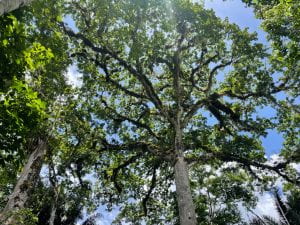
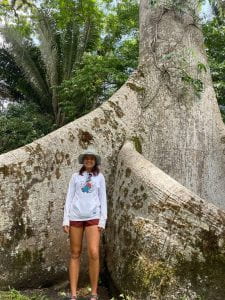
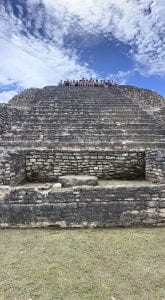

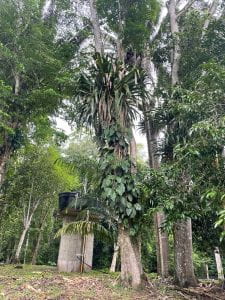
Leaving Las Cuevas
Unfortunately this morning I had a sore throat and was not feeling so good, so I had to stay in my room after breakfast. I did make the most of it however and took a nice long nap. There was some deafening thunder periodically that I could hear, often followed by periods of torrential rain.
While I was in the room the rest of the group went into the forest to collect the bug traps we had set out yesterday, and later half the group went out to find the camera traps we had put out a few days ago.
At around 3:30 vans arrived to take us out of Las Cuevas. We were a little worried that the heavy rains would have flooded the bridges we needed to cross to get out of the Chiquibul, but luckily the water levels on the rivers stayed low. The roads also were far less muddy than I expected, it seemed like they were a pretty firm sandy material that drained pretty well.
We stopped to place dinner orders right by our hotel in San Ignacio (there was some very interesting Karaoke performances we got to listen to) before we checked into our rooms. I got a very nice little bungalow with my own bathroom and a TV!
(update): the group collected and analyzed the data from the arthropod survey and camera trap research projects. We only found three deer on the camera traps so unfortunately that was not enough to make any conclusions about. For the arthropod question we did find more insects on the forest floor as we expected due to their being more nutrients there, and we did find that bugs like nutrient filled tubes (pee) more than control tubes, but contrary to our initial hypothesis that bugs in trees would be more desperate for nutrients and thus more attracted to them, we found the arthropods on the ground were actually most attracted to the pee. This could be that the arthropods that seek out nutrients most actively/directly are already on the forest floor.
Pee, Snakes, Ants, and Squishy Frogs
We started a study where we wanted to see how arthropod abundance compares on the forest floor vs canopy and what this has to do with nutrients like nitrogen. To do this, we set out bug traps in the ground and in trees some with water and some with “nutrients” (the nutrients happen to be yellow).
While we were hiking out we saw a jumping pit viper right in the middle of the path! While we were still taking pictures and admiring it, we spotted a small eyelash viper (yes it has eyelashes) curled up on a log nearby! This was the first time even the station staff who had been here for 12 years had seen one! We also saw a zombie moth that had had a fungi take over its nervous system so that it went and sat in a suitable spot for the fungus to grow out of its body.
In the afternoon we excavated some leaf cutter ant nests to see the fungal gardens that they feed their leaves to. The fungus looked like a grey fuzzy honeycomb, and we also found the queen who had birthed the whole colony. She was the size of my thumb and had ants running along her back. There were also soldier ants with powerful bites that could draw blood if you tried to pick them up.
While we excavating we found the most ridiculous animal: a Mexican burrowing toad. It was litterally like a squishy, jiggly, amorphous water-ballon pancake with a nose, eyes, and legs stuck onto it. It was black with red spots and burrowed backwards into the mud!
I also saw a surinam cockroach (pyconscelus surinamensis). It was shiny almost golden brown with a jet black head covering with a white stripe on it. It was also very speedy as it ran over our hands!

Planting Camera Traps
Today we walked alot. We designed a research question that would use motion detection triggered cameras to try and see if different sized predatory and prey mammals could be seen more on roads, trails, or in the rainforest itself.
This meant we were set to hike all over planting camera traps. It also meant we got to see some pretty amazing things as we walked. For example, pretty early into our hike we found a termites nest right on the trail! Because the termites have very little exo-skeleton, they make a high protein and easy to digest snack that much of our group tried! (They apparently taste like Carrots)
We also climbed up to a high point in the rainforest where there was a tall bird tower that let us see right over the canopy! We could see the entire mountainous landscape for miles and miles, partially cloaked in fog. It was absolutely breathtaking.
On our way down we also found a large cave where the rainwater had eroded the underlying limestone. The cave was relatively open and easy to walk around in (no intense caving yet), but it still had some really incredible things inside as it had once been used as a mayan religious site. There was shattered pottery on the ground some still with a relatively glossy orange paint on it, and also the remains of a wall the mayans had built to section off part of the cave.
One last super cool thing I wanted to mention was seeing red-eyed tree frog eggs hanging on oranges over a rather muddy former pond. The eggs are slayed there because the frogs know the pond will eventually fill up again, and when it does the tadpoles will hatch and drop into the water!. Also, if the embryos detect vibrations on their branches that feel like a snake or predator coming to eat them, they will drop into the water prematurely to maximize their survival chances!
I also saw some really cool cockroaches today. By a super large leaf cutter ant nest we found a beutiful white Panchlora zendala. It was really cool to see how comfortable members of the group felt who are usually uncomfortable with cockroaches felt holding this beautiful roach!

Also, under the bark of a log Dr. Correa found the enormous deep red/black wings of a Megaloblatta blaberoides, and also some leg and abdomen remains. Someone had clearly had a very large and delicious snack! The sheer size of the wings were absolutely astounding for one of the largest cockroaches in the world!
Entering the Rainforest!
(Sorry I won’t have any internet from here on out for a while) Today was quite a road trip. Not only were we riding in a van for like 5 hours, but it was also an extremely bouncy bumpy ride. However, it was also quite a ride in terms of what we got to see. We passed through the unique pine ridge ecosystem that is formed from an enormous geological feature that is a granite dome. We then descended into the Chiquible forest which felt much more rainforesty with dense plant cover with tall trees that had a visible canopy and vines, epiphytes, ferns, etc covering everything underneath.
Before we went to las cuevas research station where we would be staying, we stoped for an amazing tour at the Caracol mayan ruins. This was truly an insane experience. We got to climb a pyramidal temple that is the tallest building in Belize and had amazing views, view an astronomical sight that could be used to track time via where the sun was rising in the sky, and more!
On our drive through the forest we also got to see some amazing wildlife including a tiny crocodile siting on a rock, a turtle scurrying across the road, and Scarlet Macaws passing our van overhead.
I also found my first cockroach! I believe it was a Periplaneta australasia based on the body shape and the slight white markings on the head covering (pronotum) It was fluttering around the ceiling of one of the las cuevas research station bedrooms, and also causing the bedrooms inhabitants much distress!

Day 12: A Swarm of Burrowing Toads
Today we went for a speedy hike to collect the trail cams we set out on day 10. What took us many hours to set up, only took us about an hour and a half to collect. Our ability to navigate the forest terrain has substantially improved, yet there was still some slipping and sliding in the mud. There was a refreshing light rain while we were hiking, but loud and foreboding thunder out in the distance.
Thankfully we made it back before the downpour began. But with all of this rain, we could hear a cacophony of toads out in the distance. It sounded like a swarm of insects, but it was the layered calls of many many Mexican Burrowing Toads (Rhinophrynus dorsalis). We decided to quickly hike down to the frog pond, to check out their activity. Although we did see any, their mating calls surrounded us while we stood by the frog pond. Definitely a cool experience, and a perk of traveling to the forest during the wet season.
While there we were also able to check on the Tree Frog eggs, we had found a few days earlier. Now bellow them sat a substantial puddle of water from all the rain, a perfect place for them to fall into once they hatched. You could see that the tadpoles were further developed and looked more like tadpoles than just dots. Yet, it was still too early for them to hatch. I love exploring the frog pond and it was nice to see it filled with water.
